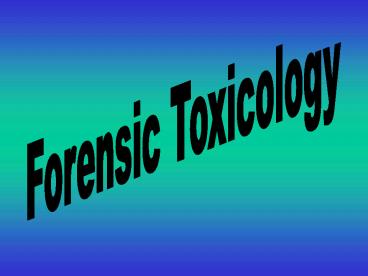Forensic Toxicology - PowerPoint PPT Presentation
1 / 12
Title:
Forensic Toxicology
Description:
A material that exerts a life threatening effect on an organism ... gas-liquid chromatography, and immunoassay- used to detect both legal ... – PowerPoint PPT presentation
Number of Views:677
Avg rating:3.0/5.0
Title: Forensic Toxicology
1
Forensic Toxicology
2
Definition
- Using the study of adverse effects of chemicals
on living organisms to aid in the investigation
of death and poisoning - Forensic toxicology is a specialty area of
analytical chemistry
3
Toxins
- A material that exerts a life threatening effect
on an organism - They may be ingested, inhaled, or absorbed
through the skin - Poisons are subgroup of toxins
4
US Poisonings
- About 2 million voluntarily reported poisonings
per year - About 700 deaths by poisoning per year
- Children under 6 account for the majority and are
accidental poisonings - Adult poisonings are mostly intentional
5
Most frequent deaths by poisoning
- 1-Antidepressant medications
- 2-Analgesics
- 3-Street drugs
- 4-Cardiovascular drugs
- 5-Alcohol
- 6-Gases and fumes
- 7-Asthma therapies
- 8-Industrial chemicals
- 9-Pesticides
- 10-Household cleaning supplies
- 11-Anticonvulsant medications
- 12-Food, plants, and insects
6
Examples of evidence collected at crime scene
- Pill bottles
- Powders
- Trace residues
- Any available chemicals
- These, of course, would make the case simpler if
found at the scene, but are not always available
7
Useful evidence involving the victims body
- Hair
- Blood
- Organ parts
- Gastric (stomach) contents
8
The challenge
- The bodys natural processes alter, or change the
composition of substances ingested - The forensic toxicologist should have the
coroners report available, which might contain
previous signs and symptoms of deceased as well
as important post mortem data
9
Detecting and classifying
- Gas chromatography- examines organic compounds
- Emission Spectroscopy, X-ray diffraction and the
Reinsch test-used to detect heavy metals - Thin-layer chromatography, gas-liquid
chromatography, and immunoassay- used to detect
both legal and illegal drugs, pollutants, and
pesticides
10
Drugs
- Drugs are usually acidic or basic in nature
- When a toxicologist isolates a drug sample, the
sample will be first tested to see if it
possesses an acidic or basic nature - Then, physical tests such as melting point
determination, boiling point determination or
density determination - Chromatography and chemical spot tests are also
used in the screening process - Finally, the use of mass spectroscopy will
confirm the identity of the drug
11
Forensic Toxicologists
- Undergraduate degree in biology or chemistry
- PhD in one of the natural sciences
12
Sources
- http//faculty.ncwc.edu/toconnor/425/425lect14.htm
- http//en.wikipedia.org/wiki/Forensic_toxicology































